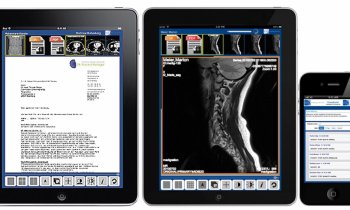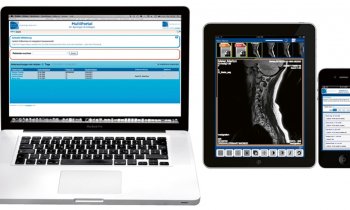Image source: Adobe Stock/Tex vector
Article • How to bring about better patient outcomes with health data
Propelling innovation in healthcare with the help of health data spaces
January 28 saw the celebration of the “Data Protection Day” as it is called in Europe, or respectively the “Privacy Day” as it is referred to outside of Europe. It marks the date on which the Council of Europe’s data protection convention, known as “Convention 108” was opened for signature back in 1981. According to the Council of Europe, it is the ‘only international, multilateral and legally binding instrument to protect privacy and personal data’.
Report: Cornelia Wels-Maug
The protection of personal data is a particularly sensitive issue in the healthcare field and has impeded to some extent the process of digitisation as well as the more widespread use of the generated healthcare data. Nevertheless, digitisation has been beneficial in streamlining workflows and facilitating the emergence of new processes to cure and prevent illnesses as well as in engaging with patients. The Covid-19 pandemic has only accelerated digitisation efforts, with especially telemedicine seeing a significant increase in acceptance.
Health data as a source for better patient outcomes
The generated health data is used for various purposes that ultimately serve to improve patient outcomes, ranging from patient management, product development, patient safety measures, quality control to research and innovation. However, there needs to be an understanding regarding the management of the healthcare data and which principles should be guiding its primary and secondary usage. Primary use includes patients having access to and control over their electronic health record (EHR) data along with health professionals being able to access their patients’ data. Secondary data usage entails the reuse of patient data for regulatory, policy making and statistical purposes as well as research.
The use of healthcare data also entails the challenge of how to protect individuals’ data. The major legal framework for the protection of personal data, including healthcare data of natural persons in Europe, is the General Data Protection Regulation (GDPR). It safeguards the processing of natural persons’ personal data as well as its free movement.
Driving innovation whilst striking a balance between data privacy and the overall health of a population
Overall, patients look for innovation to maximise patient outcome. This can be in the form of increased safety, a stronger relationship with care givers, enhanced self-care strategies or better adherence to therapeutic treatments, amongst others. The analysis of health data, especially with the use of artificial intelligence (AI), is central to achieve this. However, striking the balance between driving health outcomes via research based on the analysis of heath data and at the same time avoiding associated data protection risks can often be heavily skewed toward avoiding risks in the first place and, therefore, decreasing the chances of gaining new insights. To enable this balancing act, the idea of a European Health Data Space (EHDS) was born.
The European Health Data Space
First presented in March 2022, the European Health Data Space is designed to leverage the potential of health data by supporting the use of primary and secondary health data. To achieve this, a newly created access organisation is to decide upon the eligibility of third parties to use the data.
The EHDS will provide a trustworthy setting for secure access to and processing of a wide range of health data and builds further on the General Data Protection Regulation, the proposed Data Governance Act and the Network and Information Systems Directive. At the core lies the exchange of health data between patients and health professionals across member states of the European Union (EU). It establishes a common governance framework across EU states that combines rules, standards, practices, and infrastructures. However, it will also need the definition of strict rules for the use of individual’s non-identifiable health data for research, innovation, policy-making and regulatory activities. Some of its services are already operational in some places and the rest will be implemented progressively across member states until the end of 2025.
Recommended article

Article • Data protection
A shared EU data space for health?
The General Data Protection Regulation (GDPR), which came into force in 2018, has reinforced the European Union’s (EU) reputation of being comparatively strict regarding the protection of personal data within its member states. While the GDPR is generally considered a success, setting standards even outside its jurisdiction, critical voices are becoming louder.
Benefits of the European Health Data Space
The EHDS comes with a list of benefits for the various stakeholders involved. They range from ensuring that health data follows people to promoting a genuine single market for digital health services and products.
Individuals can immediately access their health data from their EHR and share it with healthcare professionals nationally and internationally. Researchers, industry or public institutions will have access to large amounts of health data of higher quality and only for specific purposes that benefit individuals and society. They may only access data that does not reveal the identity of the individual, whereby the data may only be accessed and processed in closed, secure environments. The EHDS will benefit the healthcare professionals as they have faster access to patients’ EHRs and easier access to health records from different systems, which significantly reduces the administrative burden.
Regulators and policymakers will also have easier, more transparent and less costly access to non-identifiable health data for the benefit of public health, the overall functioning of healthcare systems and to ensure patient safety. The data will be held in a common European format.
Case in point: The Health Outcomes Observatory H2O
Health data has the potential to inform and facilitate a richer dialogue between patients and their healthcare providers as well as improve self-management
Angèle Bénard-Sankaran
One example of an EHDS is the newly created Health Outcome Observatory (H2O). It is the first European network that aims to create a ‘robust data governance and infrastructure model to collect and incorporate patient outcomes at scale into healthcare decision making at an individual and population level’. Its concept is firmly built on the coexistence of primary and secondary usage of health data.
H2O brings together 24 partners – 13 academic institutions, small and medium enterprises and 14 pharmaceutical companies. It incorporates EHR data from providers, patient-generated-data, and those from disease registries from Spain, the Netherlands, Austria and Germany. The data can only be analysed with the patients’ consent. Initially, the initiative will collect outcome data for diabetes, inflammatory bowel disease (IBD) and cancer.
The data can be used by patients to better communicate with their clinicians, by health authorities for more informed decision making and researchers to drive new insights. It is planned to extend the H2O concept to additional data sources and other settings in the future. ‘Health data has the potential to inform and facilitate a richer dialogue between patients and their healthcare providers as well as improve self-management, thus resulting in better care for individuals and more efficient and sustainable health care systems for the entire community,’ says Angèle Bénard-Sankaran, who, until recently, was Project Manager at H2O.
22.02.2023









